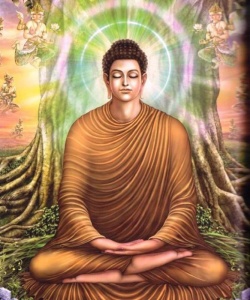Kakusandha Buddha
Krakucchandra (འཁོར་བ་འཇིག་, ‘khor ba ‘jig)
Kakusandha is known as the twenty-second Buddha in the Pali tradition. He was born in Khema Park. The name of his father was Aggidatta, who was a Brahmin priest of the king Khemankara of Khemavati. The name of his mother was Visakha. The name of his wife was Virochamana and of the son Uttara.
He renounced the worldly life on a chariot at the age of four thousand years; and practised austerities for eight months. He accepted the milk-rice from a brahmin girl Vajirindha of the village Suchirindha just before his Enlightenment; and sat on the grass seat prepared by Subhadda. He attained Enlightenment under a Sirisa tree; and delivered his first sermon to the assembly of eighty-four thousand monks in a park near Makila.
His chief disciples were Vidhura and Sanjiva among the monks; and Sama and Champa among the nuns. His principal attendant was Buddhija. Acchuta and Samana among the men; and Nanda and Sunanda among the women were his chief patrons. Acchuta built a monastery for Kakusandha Buddha on the same site, which was later chosen by Anathapindika for Jetavana Arama for Gotama Buddha.
According to the Samyutta Nikaya (ii.194) the Vepulla mount of Rajgir was then called Pachinvamsa; and the people of the region Tivara.
He died at the age of forty thousand years.
The Bodhisatta during the time of Kakusandha was born as King Khema.
See Dipavamsa ii.66, xv.25, 34; Mahavamsa xv. 57-90; Digha Nikaya ii.7; Majjhima Nikaya i.333; Buddhavamsa xxiii; Buddhavamsa Atthakatha 209 ff.
In the Buddhist texts in Sanskrit the name of the Buddha is Krakucchanda. See Divyavadana 254,418 f.; Mahavastu iii.247,330
In Buddhist tradition, Kakusandha (Pāli) is the name of the twenty-fifth Buddha, the first of the five Buddhas of the present kalpa, and the fourth of the seven ancient Buddhas. He is known in Sanskrit as Krakucchanda, and in Tibetan as Khorvadjig. Kakusandha was preceded by Vessabhū, and succeeded by Koṇāgamana. His biography is recorded in the Buddhavamsa, one of the books of the Pāli Canon. Life
Kakusandha Buddha was born in Khemavati (now Gotihawa), in Kapilavastu District, in the Lumbini Zone of southern Nepal. His father was Aggidatta, a Brahmin chaplain of the king Khemankara of Khemavati. His mother was Visakha. His wife was Virochamana (also known as Rocani); he had a son, Uttara (son of Kakusandha). Asoka visited Gotihawa, Nepal when he visited Lumbini, Nepal and installed a stone pillar and inscribed his visit in the pillar. There is also a stupa in Gothihawa. Therefore, it is generally accepted due to the pillar that the birthplace of Kakusandha is in Gothihawa, Nepal near Kapilvastu, Lumbini, Devadaha and Ramagrama of Nepal.
Kakusandha lived for four thousand years in the household in three palaces: Ruci, Suruci and Vaddhana (or Rativaddhana). At the age of four thousand, he renounced the worldly life while riding on a chariot. He practised austerities for eight months.[2] Before attaining enlightenment, he had accepted some milk-rice from the daughter of the Brahmin Vajirindha of the village Suchirindha, as well as grass for his seat from the yavapalaka Subhadda. He attained enlightenment under a sirisa tree, then delivered his first sermon to the assembly of eighty-four thousand monks in a park near Makila.
Kakusandha performed the twin miracle under a sala tree, at the gates of Kannakujja. Among his converts was a fierce yaksha named Naradeva. Kakusandha kept the fast-day (uposatha) every year.
His chief disciples were Vidhura and Sanjiva among the monks, and Sama and Champa among the nuns. His personal attendant was Buddhija. Acchuta and Samana among the men, and Nanda and Sunanda among the women were his chief lay-supporters. Acchuta built a monastery for Kakusandha Buddha on the same site, which was later chosen by Anathapindika for Jetavana Arama for Gautama Buddha.
According to the Samyutta Nikaya (ii.194), the Vepulla peak of Rajgir was then called Pachinvamsa; and the people of the region Tivara.
Kakusandha's body was forty cubits in height, and he died at the age of forty thousand years in Khemavati. The thūpa erected over his relics was one league high.
The bodhisattva who was to become Siddhartha Gautama was born as King Khema during the time of Kakusandha. Kakusandha was the Buddha who foretold that King Khema, who offered him alms with robes and medicines, would become the Gautama Buddha in the future
